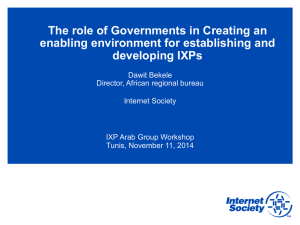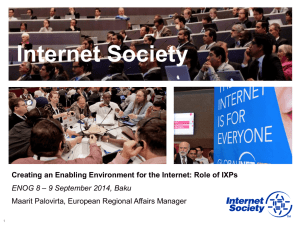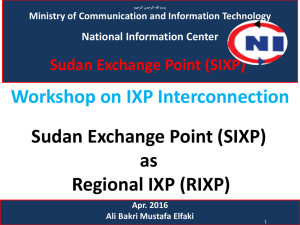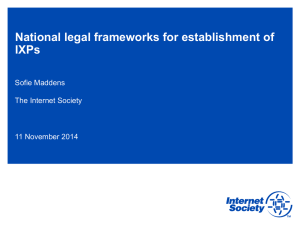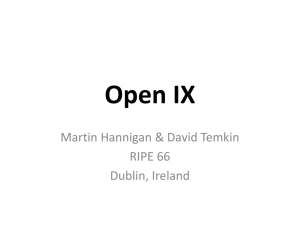National legal frameworks for establishment of IXPs Sofie Maddens
advertisement
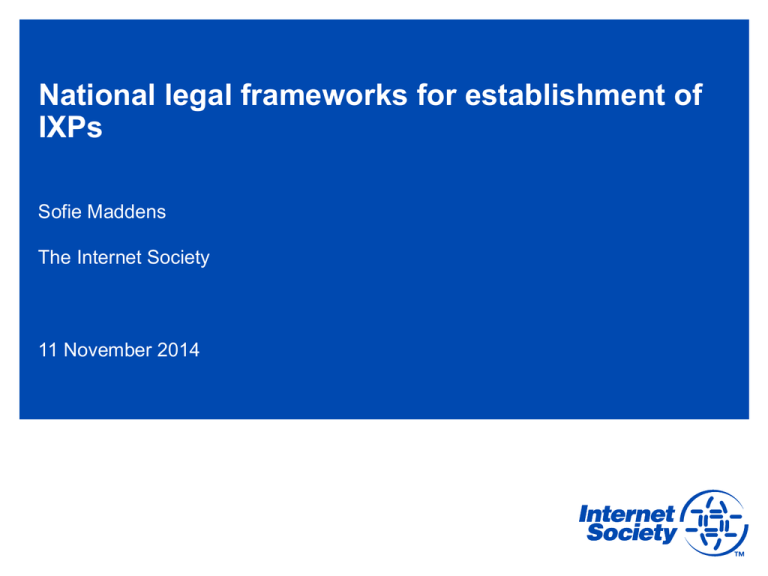
National legal frameworks for establishment of IXPs Sofie Maddens The Internet Society 11 November 2014 What is an IXP • An Internet Exchange Point (IXP) is a physical location where different IP networks meet to exchange traffic (switch, routers, cabling, ports) with each other to keep local traffic local. BUT they are much more than just “boxes and wires”: • IXPs are vital part of the Internet ecosystem, essential for facilitating a robust domestic ICT sector • Benefits of an Internet Exchange Point (IXP): • Keeps local Internet traffic within a local infrastructure, and reduces costs associated with traffic exchange between networks. • Builds local Internet community and develops human technical capacity – better net management skills and routing • Improves the quality of Internet services and drive demand in by reducing delay and improving end-user experience • Convenient hub for attracting hosting key Internet infrastructures within countries – content is key and confidence builds in local infra when delivery is consistent and reliable • Catalyst for overall Internet development Role of IXPs • A primary role of an Internet Exchange Point (IXP) is to keep local Internet traffic within local infrastructure and to the reduce costs associated with traffic exchange between networks. • improve the quality of Internet services and drive demand in by reducing delay and improving end-user experience • convenient hub for attracting hosting key Internet infrastructures within countries • Catalyst for overall Internet development • Not limited to commercial ISPs, wide rage network or data service can benefit from participating • E-Gov, Universities, etc. 3 Formula for Development: What kind of infrastructure is needed for an IXP? • Important to think of IXPs beyond the “Boxes and Wires” Technical Infrastructure • 3 types of infrastructure • Technical • Governance • Human Governance Infrastructure Human Infrastructure • IXP projects are most vulnerable when the key focus is on physical infrastructure: 80/20 • Human infrastructure and capacity building is the key driver of success and sustainability 4 Technical Infrastructure IXPs need not be expensive to be effective. The London Internet Exchange (LINX), now one of the largest IXPs in the world, started with 5 members and a donated switch. 5 IXPN - Nigeria Human Infrastructure • A critical factor for start-up and sustainability. • Understanding the value proposition • Trust and relationship building is essential • Technical Capacity Building • Both at the network operator/IXP participant level and the IXP operations level. • Building local and regional communities of practice to sustain and grow knowledge. International cooperation. • Reducing the information asymmetry to empower local and international opportunities IXP 80/20: “80% Social Engineering, 20% Technical Engineering”" 6 Governance Infrastructure • Community Involvement 7 • The technical community is key to running the IXP (development, operations, technical management). • Policy-makers and Regulators can help create an enabling environment ICT policy-level support policies § Eliminating content-provider, foreign network (no local operations except exchanging traffic at the IXP), and IXP licenses where these are in place or being considered. § Mandating the sharing of essential facilities, telecommunication infrastructure, civil works and access to alternative infrastructure provided by transport and energy operators, especially for land-locked countries. § Addressing issues that limit the ability of infrastructure developers and Internet service providers to cross borders, particularly the need for harmonisation of regulations between neighbouring countries and the lack of clarity from governments about permissions for use of cross-border ROWs and areas designated as “no-man’s land.” § Promoting awareness of the need for all local carriers, ISPs and content providers to connect to IXPs so that the development of local content is encouraged and the aggregation of traffic is enabled, thus allowing developing regions to become locations to which the international providers wish to connect rather than continuing to be the ‘client’ regions where providers must pay all of the costs of connecting to global backbones ICT policy-level support policies § Recognising the important role of the public sector in financing infrastructure development in remote and less population-dense areas that may not be initially profitable for private operators. Related to this consideration is the need for financing of redundant infrastructure in these areas to improve the reliability of service provision. § Increasing the support for information sharing and multistakeholder consultation to understand and address concerns of all affected parties in policy development and to build relationships and trust between the various players. § Increasing the level of support for relationship building, technical training, and skills development to ensure that network operators can more effectively use existing IXPs and quickly implement IXPs in the countries where these are not yet present. § Promoting awareness at the top levels of leadership within government, in regional governmental agencies, and in the international development assistance community, of the importance of IXP-related issues and of implementing policy changes necessary to promote IXP and Internet ecosystem development. National regulators also need special focus and specific awareness raising events to help build internal awareness about the importance of IXP development. These events could be attached to existing fora such as the regional regulatory association meetings. Source: http://www.internetsociety.org/sites/default/files/Global%20IXPToolkit_Collaborative%20Draft_Feb%2024.pdf Keeping IXPs in Context… § IXPs can be a catalyst of a robust Internet environment and market. § Many other issues are involved in promoting a robust interconnection and traffic exchange environment in a country / region." § Barriers and bottlenecks along the service chain are various and challenging:" – Backhaul and Leased Capacity" § More costly to send traffic from Abuja to Lagos, than Lagos to London. Cape Town to Jo’burg similar" – Cross-border connectivity, policy and licensing issues" – International gateways, landing stations" § With falling international capacity prices (including around Africa), there is also opportunity to take advantage of international peering opportunities. " § ISOCs situates its IXP work within the broader interconnection and traffic exchange (ITE) context. " 10 Concluding Thoughts Below is some Food for Thought for Policy-makers and Regulators. 11 • Are you removing bottlenecks to investment? • Are you working with the technical community to understand the Internet technical infrastructure? • What do you need to do to promote a competitive environment for the IXP? • Do you really need to regulate or do you simply need to allow the IXP to develop? • Does your legal regime require a "measure" to be taken to allow for the IXP? If yes, try to keep it flexible. • Have you taken a look at terrestrial fibre costs in your country and what you can do to lower costs? Thank you for your attention! Questions? " Sofie Maddens | maddens@isoc.org
